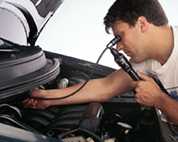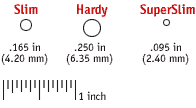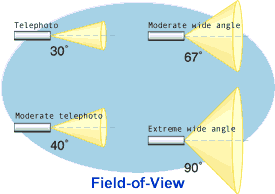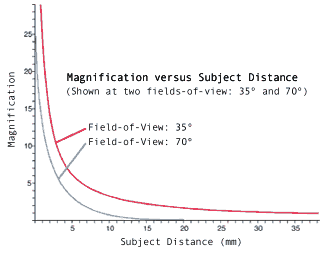Choosing a Borescope
Every day, we help people select the right borescope and accessories for their specific application. A trained Optimax Endoscope representative will be very happy to help you. Call us at 01858 436940 or E-mail us at info@optimaxendoscopes.co.uk.
Rigid or Flexible?
| |
 |
|
|
|
 |
|
|
Rigid borescopes give higher quality images, are easier to use and are less expensive than flexible scopes of similar quality. Choose a rigid borescope unless the rigidity is a problem. Then you need...
|
|
...A flexible fiberscope lets you see inside spaces that a rigid borescope can't penetrate. Hawkeye Blue Flexible borescopes can offer the additional benefit of articulation — the ability to remotely control the tip of the scope so that it bends in two or four directions to look around a cavity.
|
| |
|
|
Diameter
The borescope must fit through the smallest hole required. When choosing a borescope diameter, consider more than clearing the sides of the hole. A slightly smaller scope may allow "wiggle room" so that you can see more by tilting the scope. The best thing is to try it. If you need to see into very small holes and relatively large ones, it is usually best to optimize for each, by using two borescopes. The Hawkeye MicroSlim borescope can fit into a 1.85mm diameter hole.
Hawkeye Borescope Outer Diameter Sizes

Length
Choose a borescope to penetrate to the greatest depth required, but not so long as to be unwieldy outside the hole. Hawkeye and Hawkeye Blue borescopes are available in a variety of lengths from 50.8 mm to 940 mm for rigid scopes and 0.7 m to 1.8 m for flexible borescopes.
Direction-of-View

Take a longitudinal axis through the center of the body of a rigid borescope, or the tip of a flexible. The direction-of-view is the angle from that axis of the center of the field-of-view.
Look at your particular application, noting the point of borescope entry and the area to be examined. If the subject is straight ahead of a convenient entry hole a 0° direction-of-view might be best. If the subject is very close to the entry port, like engine valves near a spark plug hole, a backward-looking 120° borescope might be best. When examining a bore, like a rifle barrel, a 90° Mirror Tube will be perfect.
Field-of-View

Field-of-view may be very wide, wide, medium, or narrow. Think of it as a cone coming from the borescope tip, so that anything within the cone is visible. The field-of-view of the Hawkeye Slim borescope is approximately 37°.
Field-of-View should be dictated by the distance from the distal end of the borescope to the subject, for your application. The wider the field the lower the magnification, and vice versa. If you have plenty of space to move inside the cavity, but want to see both detailed close-ups and big picture views you might choose a 67° moderate wide angle. If the space is more confined but you still need to see most of it at one time, try a 90° extreme wide angle. On the other hand, if you can't get close enough to show the detail you need, a 30° telephoto might be required.
Magnification

Microscopes and loupes have very limited depth of field — they are only in clear focus at a single distance, so the magnification is also fixed. A borescope, however, has a very large depth of field — often from infinity down to an inch or less — that makes them easy to use without constant refocusing. The closer an object is to the lens of a borescope, the greater the magnification. To calculate magnification you must know the distance of the subject from the lens. The same principles apply to rigid or flexible borescopes.
Illumination
Before you can see anything in a dark cavity, you need some light on the subject. Prior to 1960, borescopes used hot and often dangerous incandescent lamps at the distal (working) end. Today, quality borescopes usually uses fiber optic illumination, where glass fibers carry light from an external light source through a flexible light guide, then through the borescope, to the distal end. Some inexpensive borescopes still use a bulb at the tip of the scope for illumination, which can lead to illumination, heating and contamination problems. All Hawkeye and Hawkeye Blue borescopes use fiber optic illumination in the scope body and can connect either directly with Mini-Maglite or NOVA or Mini-NOVA light sources for portable operation or the brighter wall powered Luxxor 50 and Luxxor 24 light sources.